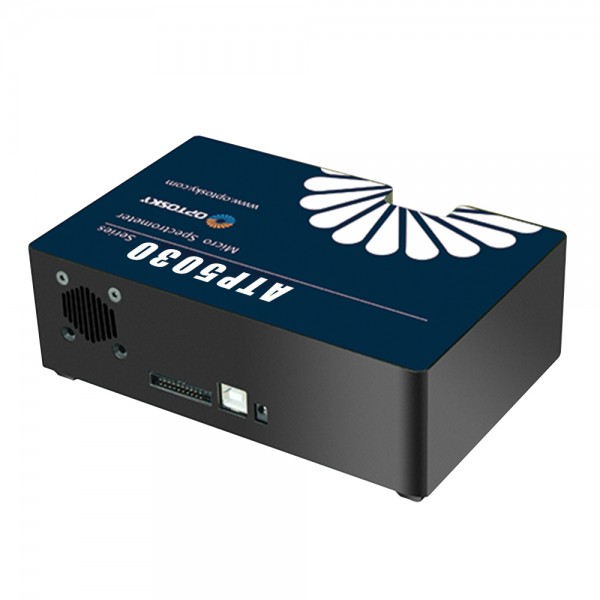Your shopping cart is empty!
High-resolution Spectrometer
Availability: In Stock
High-resolution Spectrometer
Download Data Sheet
Product Code: ATP5034
application
ATP5034 is a cooled, ultra-high resolution micro spectrometer newly developed by Optosky, ATP5034 is based on the M-type C - T optical path structure independently developed by Optosky, with extraordinary ultra-high resolution;at the same time, it uses a cooled 2048 or 4096 pixel linear array detector to achieve the ultimate ultra-high resolution, the highest resolution can reach 0.05nm. It is a miniature spectrometer suitable for various high-resolution applications, with high reliability, ultra-high speed, low cost, and high cost
performance. It can be adapted to various environmental uses such as online testing.
ATP5034 adopts TEC electric cooling, the cooling temperature is -5℃. Greatly reduce the dark current and noise of the spectrometer, and improve the dynamic range and signal-to-noise ratio of the spectrometer.
ATP5030 can receive SMA905 optical fiber input light or free space light, and output the measured spectrum data through USB2.0 or UART port.
ATP5030 only needs a 5V DC power supply, which is very easy to integrate and use.
| Detector | |
| Detector type | Linear array detector |
| Spectral range | 200-1100 nm |
| Effective pixels | 2048 or 4096 pixels |
| Pixels dimension | 14μm×200μm |
| Sensitivity | 1300 V/(lx·s) |
| Dark noise | 13 RMS @ 13 ˚C |
| Optical parameter | |
| Stray light | <0.05% at 600 nm; <0.09% at 435 nm |
| Focal distance | 75mm |
| Optical resolution | 0.07-3 nm |
| Incident Interface | SMA905 connector |
| Signal-to-noise | >600:1 |
| Dynamic range | 8.5×10^7 (system); 2000:1 for a single acquisition |
| Working temperature | -25 ~ 50 ℃ |
| Working humidity | < 90% RH |
| Cooling temperature | TEC cooled, -5 ˚C |
| Wavelength range | 200-1100nm |
| Slit Size | 50 μm (10, 25, 100, or 200 μm option al) |
| Optical Design | M-type Czerny-Turner |
| Physical parameters | |
| Dimensions | 135 × 99 × 46 mm |
| Weight | 0.5 kg |
| Sealing | Anit-sweat |
| Electrical parameter | |
| A/D conversion resolution | 16 bit |
| Integration time | 0.1 ms - 256 second |
| Interface | USB Type-C |
| Supply voltage | DC4.5 to 5.5 V (type @5V) |
| Operating current | 1.5 A@Typ. 3A Max |
| Storage temperature | -30°c to + 70 °c |
- Detector cooling temperature: -5 ℃.
- M type optical path, higher resolution.
- Spectral range: 200-1100 nm.
- Spectral resolution: 0.05 ~ 2 nm.
- Optical path structure: non-crossing C-T.
- Detector: 2048 pixels.
- Integration time: 0.1ms ~ 256s.
- Power supply: DC 5V power supply.
- ADC bit depth: 16 bits.
- Data output interface: USB Type-C.
- 20-pin expansion interface.
- LIBS,Plasma luminescence detection
- Raman spectroscopy detection
- Wavelength monitoring, laser, LED and other luminous bodies
- Water quality analyzer
- UV flue gas analyzer
- LED sorting machine, color detection
- Spectral analysis, radiation spectroscopic analysis, spectrophotometric analysis
- Reflection and transmission spectrum detection
What are High Resolution & High Sensitivity & TE cooled Spectrometer from Optosky?
ATP5100 Ultra-miniature, Cooled BT CCD, sized up to a coin.
ATP5040 crossed C-T, TE-cooled 4096 pixels CMOS external cooling, high sensitivity
ATP5020P crossed C-T, Hamamatsu CCD cooled, higher sensitivity, SNR & dynamic range is higher than Maya.
ATP5030P M-shape C-T, higher resolution and low stray light, Hamamatsu CCD
ATP5030 (2048pixels) & ATP5034 (4096pixels) CMOS+TE-cooler, M-shape C-T, high resolution
ATP5330 (2048pixels) & ATP5334 (4096pixels) Thin, cooled CMOS+TE cooled, M-shape C-T, super high resolution
How many topology structure of optical path for a spectrometer?
There are commonly divided into 4 types of optical path, including crossed C-T, M-shape C-T, concave grating optical path, transmittance grating opitcal path.
Crossed C-T: ATP2000P,ATP2002, ATP2400, ATP1010, ATP5020P, ATP5040, ATP6500
M-shape C-T: ATP3030, ATP3034, ATP3330/4 ATP5030, ATP5034, ATP5330/4
Concave grating: ATP4230, ATP4020, ATP4050, ATP4070
let's see the M-shape optical path looks like a number "3", so our models uses the 3rd number "3" to indicate M-shape optical path models.
In generally, topology structure can decide resolution, sensitivity, stray light, and size of a spectrometer.
Crossed C-T topology structure employs better sensitivity and compact size.
M-shape C-T employs higher resolution and better stray light.
Concave grating optical path employs high stray light.









